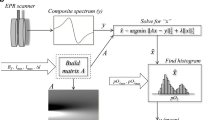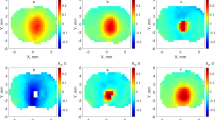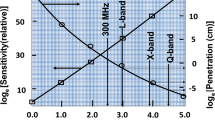Abstract
We have previously reported a high-spatial-resolution multisite electron paramagnetic resonance (EPR) oximetry method that is based on consecutive applications of magnetic field gradients with the same direction but different magnitudes. This method that could be called also two-gradient convolution EPR oximetry has no restrictions for the shape of solid paramagnetic materials implanted in tissue and is applicable for any particulate EPR oxygen-sensitive matieral with a Lorentzian line shape. To enhance the utilization of this method, a previously described algorithm was used to develop user-friendly Windows-based software. Practical conditions of application of the method were established using several different model systems. It has been shown that the spectral overlap from the adjacent sites can be neglected if the splitting between the corresponding lines exceeds the largest line width by at least a factor of 1.3. An additional requirement of the method is that the second field gradient should exceed by at least 30% the value of the first gradient. It was confirmed that the error in line width determination at L-band is proportional to the noise-to-signal ratio, and does not exceed 1% a noise-to-signal ratio of 0.1 in a typical in vivo experiment. We demonstrate that the line widths of up to 10 different sites can be determined.
Similar content being viewed by others
References
Swartz H.M., Dunn J., Grinberg O., O’Hara J., Walczak T. in: Oxygen Transport to Tissue XIX (Harrison D.K., Delpy D.T., eds.), Advances in Experimental Medicine and Biology, vol. 428, pp. 663–670. New York: Plenum 1997.
Lei H., Grinberg O., Nwaigwe C.I., Hou H.G., Williams W., Swartz H.M., Dunn J.F.: Brain Res.913, 174–179 (2001)
Smirnov A.I., Norby S.W., Clarkson R.B., Walczak T., Swartz H.M.: Magn. Reson. Med.30, 213–220 (1993)
Grinberg O.Y., Smirnov A.I., Swartz H.M.: J. Magn. Reson.152, 247–258 (2001)
Smirnova T.I., Smirnov A.I., Clarkson R.B., Belford R.L.: Magn. Reson. Med.33, 801–810 (1995)
Nilges M., Walczak T., Swartz H.M.: Phys. Med.5, 195–201 (1990)
Hirata H., Walczak T., Swartz H.M.: J. Magn. Reson.142, 159–167 (2000)
Turek P., Andre J.J., Giraudeau A., Simon J.: Chem. Phys. Lett.134, 471–476 (1987)
Author information
Authors and Affiliations
Rights and permissions
About this article
Cite this article
Grinberg, V.O., Smirnov, A.I., Grinberg, O.Y. et al. Practical conditions and limitations for high-spatial-resolution multisite EPR oximetry. Appl. Magn. Reson. 28, 69–78 (2005). https://doi.org/10.1007/BF03166994
Received:
Revised:
Issue Date:
DOI: https://doi.org/10.1007/BF03166994




